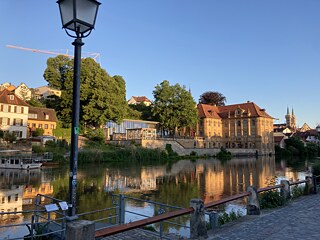Word! The Language Column
The Translator’s Yoke

Translation is an art, explains poet, reciter and our new columnist Nora Gomringer. And it’s backbreaking work, like that of a water buffalo toiling in a rice paddy – though she means that far more appreciatively than it sounds.
By Nora Gomringer
I’d been watching the dubbed German version of The Simpsons for years when I finally heard the original in English for the first time… and I was horrified. Homer sounds like an idiot, Marge’s voice sounds very smoky, Lisa’s squeaky and Bart’s obnoxious. The entire “cast” of voice actors in Matt Groening's series are thus typecast to all eternity, their “real” voices in the original firmly fixed in the minds of even German fans of the Simpsons, now that the original version is available on the streaming services used by so many young viewers nowadays. But I, for one, was so gobsmacked by the “real” voices that I couldn’t help mulling the bigger question of whether what you say changes according to how you say it.
I was only 17 at the time and, although I already thought myself old and wise, I’d completely overlooked the fact that almost all the literature I’d read till then had lain, stood or flickered before my eyes in German translation. I was an ardent Stephen King fan and considered him a philosopher among horror writers (as I still do to this day!), so I suddenly felt challenged to reread my favourite books in English and compare the originals to the translations. And lo and behold, what a world opened up to me!
An art
A world in which I came to understand that the translator is the one who explains to me in my language how my hair has to stand on end, while the author, leaning over from his world, describes to me why. To this day, I know of only a handful of translators whose very mention causes a brief pause in the conversation. In music, these pauses are fermatas, little arcs of sunlight or rainbows in the score. The space of a second for a nimbus of reverence for an artist’s work.Translating is an art. A reaction ferry was set up on the river Regnitz in front of my house in Bamberg a few years ago. It translates the force of the current on a fixed tethered cable to propel the ferry across the water. The crossing is smooth, speeding up or slowing down according to the current, though it seldom takes more than a minute or two. A ferryman or ferrywoman has to “push the rudder hard over” and secure it to keep the boat from turning with the current. If only because I love all this nautical lingo, I take the ferry a couple times a week, gazing at my house as I drift away from or towards it. Back in the old days, you had to hail the ferryman by hollering, “Sieber, hol ieber!” (“Sieber, carry me across”), and hope that Mr Sieber would lend a sympathetic ear to your request that particular day. Mr Sieber was an Übersetzer – someone who ferried you across.

Ferrymen
The Austrian poet Robert Schindel wasn’t the first writer to refer to translators as “Fährmänner” (“ferrymen”), but it made a lasting impression on me. This way of describing such a vital literary profession has stuck in my mind ever since he gave a reading in Bamberg when I was 19. Schindel read from Gebürtig, his debut novel, and since then we’ve met often, with me, a writing caterpillar, gradually emerging from my cocoon and metamorphosing into a reading, singing moth of the stage. I'm not exaggerating for effect here. The nocturnal nature of the writer’s trade does make moths of us, and there’s something naturally crepuscular about our striving to reach the reading public, who then, in turn, hold out books for us to sign under reading lamps after literary events. Book fairs and readings at schools are, admittedly, exceptions.Being a ferryman – I’ve also heard this word used in connection with Felicitas Hoppe and Ilma Rakusa, as well as Hans Wollschläger, whose very name carries a nimbus that takes my breath away to this day. Translating Homer's Odyssey and Joyce’s Ulysses was a brilliant move by a translator with a passion – for self-torment. Yes, translating us vain authors, even wanting to translate us, is self-torment in the extreme, for how often are we unavailable for discussion and provide no help at all with the questions that come up in such a painstaking and thoroughgoing immersion in the text?
Vital beasts of burden
A translator brings to light all that’s unsound and without foundation, all that’s flawed, feeble and false in the text. He’s not an editor, he usually has a fully finished product to work with, one that’s been on the market for a long time, with all its vim and vigour – and all its flaws and weaknesses, too. Like a hardworking water buffalo, the translator takes up his yoke and drags the text through a rice paddy, harvesting words and rice grains one by one. No one likes being compared to a farm animal, it makes us indignant. But if we think about the beauty of Asian calligraphy, the vital importance of these beasts of burden to the harvest and to work and rural life in general there, doesn’t that take the edge off our indignation?Toiling under the yoke of the text – this is how I’d describe translating. But I’ve come up with far harsher terms for translation in the past, especially from a writer’s point of view: I called it hostage-taking and accused translators of taking the texts they translate hostage. The text must be released in the target language word by word and allowed to set forth on its own pursuit of liberty there. More on this score in my next column.
How do you like Germany #noFilter
Help us to improve our magazine and take our survey! Thank you!
>> To the survey
Word! The Language Column
Our column “Word!” appears every two weeks. It is dedicated to language – as a cultural and social phenomenon. How does language develop, what attitude do authors have towards “their” language, how does language shape a society? – Changing columnists – people with a professional or other connection to language – follow their personal topics for six consecutive issues.